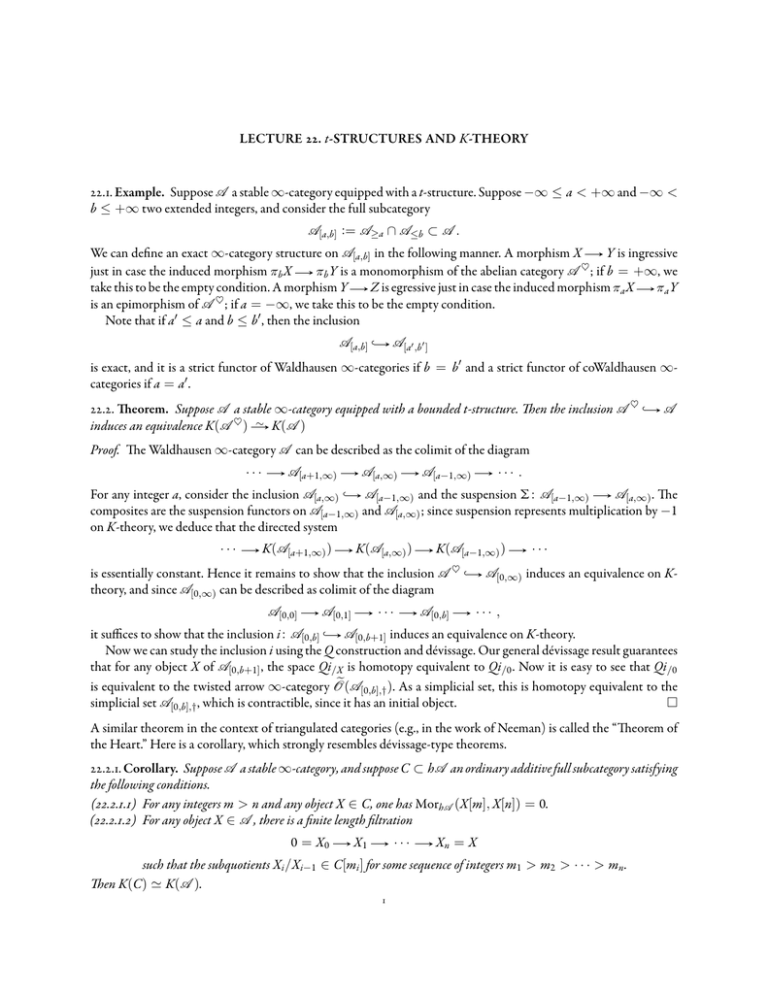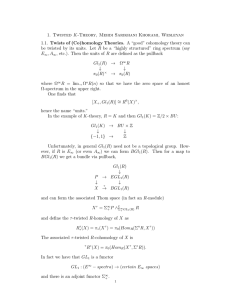t .. Example. Suppose := We can define an exact
advertisement

LECTURE . t-STRUCTURES AND K-THEORY
.. Example. Suppose A a stable ∞-category equipped with a t-structure. Suppose −∞ ≤ a < +∞ and −∞ <
b ≤ +∞ two extended integers, and consider the full subcategory
A[a,b] := A≥a ∩ A≤b ⊂ A .
We can define an exact ∞-category structure on A[a,b] in the following manner. A morphism X . Y is ingressive
just in case the induced morphism π b X . π b Y is a monomorphism of the abelian category A ♡ ; if b = +∞, we
take this to be the empty condition. A morphism Y . Z is egressive just in case the induced morphism π a X . π a Y
is an epimorphism of A ♡ ; if a = −∞, we take this to be the empty condition.
Note that if a′ ≤ a and b ≤ b′ , then the inclusion
A[a,b] .
A[a′ ,b′ ]
is exact, and it is a strict functor of Waldhausen ∞-categories if b = b′ and a strict functor of coWaldhausen ∞categories if a = a′ .
.. eorem. Suppose A a stable ∞-category equipped with a bounded t-structure. en the inclusion A ♡ .
induces an equivalence K(A ♡ ) . ∼ K(A )
A
Proof. e Waldhausen ∞-category A can be described as the colimit of the diagram
··· .
A[a+1,∞) .
A[a,∞) .
A[a−1,∞) .
··· .
For any integer a, consider the inclusion A[a,∞) . A[a−1,∞) and the suspension Σ : A[a−1,∞) . A[a,∞) . e
composites are the suspension functors on A[a−1,∞) and A[a,∞) ; since suspension represents multiplication by −1
on K-theory, we deduce that the directed system
··· .
K(A[a+1,∞) ) .
K(A[a,∞) ) .
K(A[a−1,∞) ) .
is essentially constant. Hence it remains to show that the inclusion A ♡ .
theory, and since A[0,∞) can be described as colimit of the diagram
A[0,0] .
A[0,1] .
··· .
A[0,b] .
···
A[0,∞) induces an equivalence on K··· ,
it suffices to show that the inclusion i : A[0,b] . A[0,b+1] induces an equivalence on K-theory.
Now we can study the inclusion i using the Q construction and dévissage. Our general dévissage result guarantees
that for any object X of A[0,b+1] , the space Qi/X is homotopy equivalent to Qi/0 . Now it is easy to see that Qi/0
e [0,b],† ). As a simplicial set, this is homotopy equivalent to the
is equivalent to the twisted arrow ∞-category O(A
simplicial set A[0,b],† , which is contractible, since it has an initial object.
□
A similar theorem in the context of triangulated categories (e.g., in the work of Neeman) is called the “eorem of
the Heart.” Here is a corollary, which strongly resembles dévissage-type theorems.
... Corollary. Suppose A a stable ∞-category, and suppose C ⊂ hA an ordinary additive full subcategory satisfying
the following conditions.
(...) For any integers m > n and any object X ∈ C, one has MorhA (X[m], X[n]) = 0.
(...) For any object X ∈ A , there is a finite length filtration
0 = X0 .
··· .
X1 .
Xn = X
such that the subquotients Xi /Xi−1 ∈ C[mi ] for some sequence of integers m1 > m2 > · · · > mn .
en K(C) ≃ K(A ).
.. Example (cf. Blumberg–Mandell). Suppose A a connective E1 -ring. We say that A is le coherent if () every
finitely generated le ideal of π 0 A is finitely presented, and () for every integer m ≥ 0, the le π 0 A-module π m A is
finitely presented.
If A is le coherent, then a le A-module M will be said to be almost perfect if () for every integer m, the le
π 0 A-module π m M is finitely presented, and () for every sufficiently small integer k, the π 0 A-module π k M = 0.
In this case, the full subcategory of Modℓ (A) spanned by the almost perfect le A-modules inherits the t-structure
from Modℓ (A), which is right bounded, but not le bounded. Its heart is the nerve of the ordinary category of
presentable le π 0 A-modules. Call a le A-module M coherent if it is almost perfect and if, for every sufficiently
large integer k, one has π k M = 0. In other words, M is coherent if the π 0 A-modules π m M are all finitely presented,
and they are almost all zero.
Denote by G(A) the K-theory of the full subcategory Cohℓ (A) of Modℓ (A) spanned by the coherent le Amodules M. e eorem of the Heart now implies that G(A) ≃ G(π 0 A).
We’ll say that a le coherent E1 -ring A is pseudoregular if Perfℓ (A) = Cohℓ (A). For pseudoregular E1 -rings A,
of course, G(A) ≃ K(A).
e sphere spectrum S is le coherent but not pseudoregular, so G(S) ≃ K(Z), but K(S) ̸= K(Z).
.. Example. Suppose S a set of prime numbers. Let ES be the full subcategory of Coh(HZ) generated under
extensions by the objects
Z,
{Z/p | p ∈ S},
{Z/p[1] | p ∈
/ S}.
en ES is an abelian category whose K-theory coincides with the K-theory of Z.
.. Example (Stanley’s classification of t-structures). Suppose R a commutative, noetherian ring of finite Krull
dimension. A perversity for R is a function
Φ: Z .
Z (Spec R),
where Z (Spec R) denotes the set of Zariski closed subsets of R, such that Φ(m) ⊂ Φ(m + 1) for any m ∈ Z. Such
a perversity is said to be comonotone if, for any m ∈ Z and any p ∈ Φ(n) and for any maximal proper subset q ⊊ p,
one has q ∈ Φ(n + 1).
For any perversity Φ of R, denote by Mod(HR)Φ≥0 the full subcategory of Mod(HR) generated under colimits
and extensions by the HR-module
⊕ ⊕
MΦ :=
(R/p)[m].
m∈Z p∈Φ(m)
Φ
is defines a t-structure on Mod(HR) with truncation functors τ Φ
≥0 and τ ≤0 , called the t-structure with perversity
Φ.
Consider the following assertions.
Φ M is again coherent.
(..) For any coherent HR-module M, the truncation τ ≤0
(..) e t-structure on Mod(HR) with perversity Φ restricts to a t-structure on Coh(HR).
(..) e perversity Φ is comonotone.
It is not hard to prove that the first two conditions are equivalent, and they imply the third. e third condition
is known to imply the first when R has a dualizing complex by work of Bezrukavnikov and Deligne. In general it’s
conjectured that these three conditions are equivalent. It turns out that any t-structure on Coh(HR) has a corresponding perversity, so this result/conjecture amounts to a complete characterization of t-structures on Coh(HR).
e G-theory of R can be identified as the G-theory of the heart of any such t-structure, which can in turn be thought
of as the abelian category of perverse coherent sheaves on Spec R.





